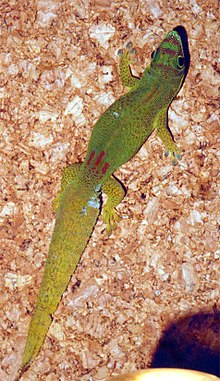Flat-tailed day gecko
| Flat-tailed day gecko | |
|---|---|

| |
| Scientific classification | |
| Domain: | Eukaryota |
| Kingdom: | Animalia |
| Phylum: | Chordata |
| Class: | Reptilia |
| Order: | Squamata |
| Family: | Gekkonidae |
| Genus: | Phelsuma |
| Species: | P. serraticauda
|
| Binomial name | |
| Phelsuma serraticauda Mertens, 1963
| |

| |
The flat-tailed day gecko (Phelsuma serraticauda) is a diurnal gecko lives in eastern Madagascar. It is endangered due to illegal collection for the international pet trade. It typically inhabits rainforests and dwells on trees. The flat-tailed day gecko feeds on insects and nectar.
Description[edit]
This lizard can reach an average total length of about 13 cm whereas females are slightly smaller. Some males may even reach a length of 15 cm. The body colour is dark green or yellowish green. Remarkable is the broad, flattened tail with serrated edges. On the lower back three red tear-shaped markings dots are present. On the neck, which may be bluish, two longitudinal yellow stripes are present. On the snout and head, there are three transversal red bars.
Distribution[edit]
This species occurs on the east coast of Madagascar. It is only known from the region 12 km north of Toamasina.
Habitat[edit]

Phelsuma serraticauda is largely restricted to coconut palms yet can also be found on banana trees.
Diet[edit]
These day geckos feed on various insects and other invertebrates. They also like to lick soft, sweet fruit, pollen and nectar.
Behaviour[edit]
This species lives in groups with one male and up to five females. Amongst the females, there is a well-developed dominance hierarchy. Juveniles are tolerated up to a certain size.
Reproduction[edit]
The females lay up to 4 pairs of eggs per year. At a temperature of 28 °C, the young will hatch after approximately 53–58 days. The juveniles are typically 40 mm in length.
Captivity[edit]
The flat-tailed day gecko is endangered due to illegal collection for the international pet trade.[1]
These animals should be housed in pairs or small groups and need a large, well planted terrarium. The temperature should be between 25 and 28 °C. The humidity should be maintained between 75 and 90%. In captivity, these animals can be fed with crickets, wax moth larvae, fruit flies, mealworms and houseflies.
References[edit]
- ^ a b Glaw, F.; Rabibisoa, N.; Randrianantoandro, J.C.; Ratsoavina, F. & Raxworthy, C.J. (2011). "Phelsuma serraticauda". The IUCN Red List of Threatened Species. 2011. IUCN: e.T172948A6946588. doi:10.2305/IUCN.UK.2011-2.RLTS.T172948A6946588.en. Retrieved 14 January 2018.
- Henkel, F.-W. and W. Schmidt (1995) Amphibien und Reptilien Madagaskars, der Maskarenen, Seychellen und Komoren. Ulmer Stuttgart. ISBN 3-8001-7323-9
- McKeown, Sean (1993) The general care and maintenance of day geckos. Advanced Vivarium Systems, Lakeside CA.

